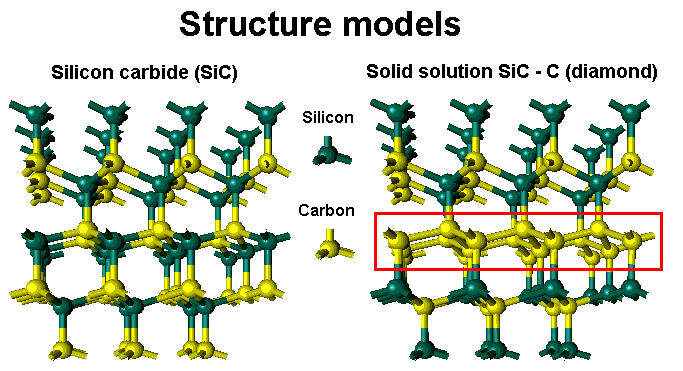Structure model
Solid solution SiC - C (diamond)
It is well-known that silicon carbide (SiC) is a stoichiometric compounds. Originally, it was pointed out by Lely that this compound has a small deviation (10-5 at. %) from stoichiometric composition SiC . However, in further investigations (Shaffer, 1969; Sorokin et al., 1983) it was demonstrated that, depending on the structure polytype of SiC, its composition can change in the direction of excess silicon in the limits 1 < Si/C < 1.049. On the basis of data concerning a decrease in the lattice parameter of SiC (a = 4.347(1) Å) in comparison with the tabulated value (a = 4.3589(1) Å) von Bonnke & Fitzer (1966) argued that a silicon carbide with suprestoichiometric carbon is formed due to the substitution of some silicon atoms by carbon ones. Recently, based on
microhardness data (sintered samples have microhardness 40 GPa), Raman spectra, lattice parameter determination (a < 4.3540 Å) and X-ray microstructure analysis our group have made a conclusion similar to the one mentioned above. Indeed, the very high microhardness in comparison with standard b-SiC (~ 29 GPa) may point out the presence of sp3 C-C bonds in the SiC structure.![]()
Using different crystal structure analysis methods a crystal structure model of SiC-C was developed. The model is based on the location of carbon along silicon carbide's close-packed planes of {111}. It was found that the carbon atoms in the
b-SiC structure arrange either as infinite defects (diamond-like carbon interlayers) after synthesis or as non-correlated point defects (in particular, carbon anti-sites) after some treatments.
Notation to picture:
The red rectangle shows the difference between perfect crystal structure of silicon carbide (the left side of the picture) and SiC-C crystal structure (the right side of the picture). In the SiC structure the closest neiboring is at the same time in our SiC-C.
![]()